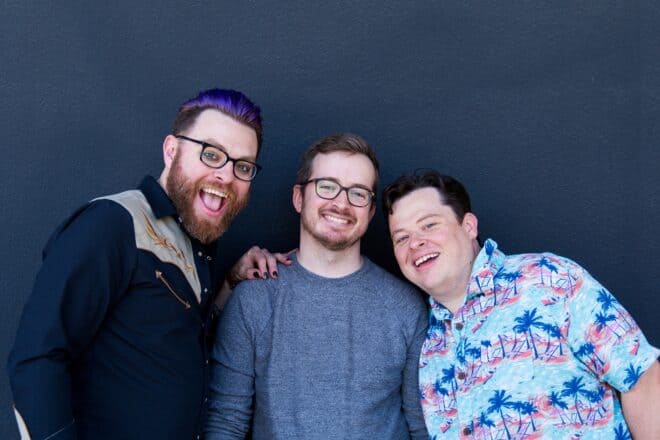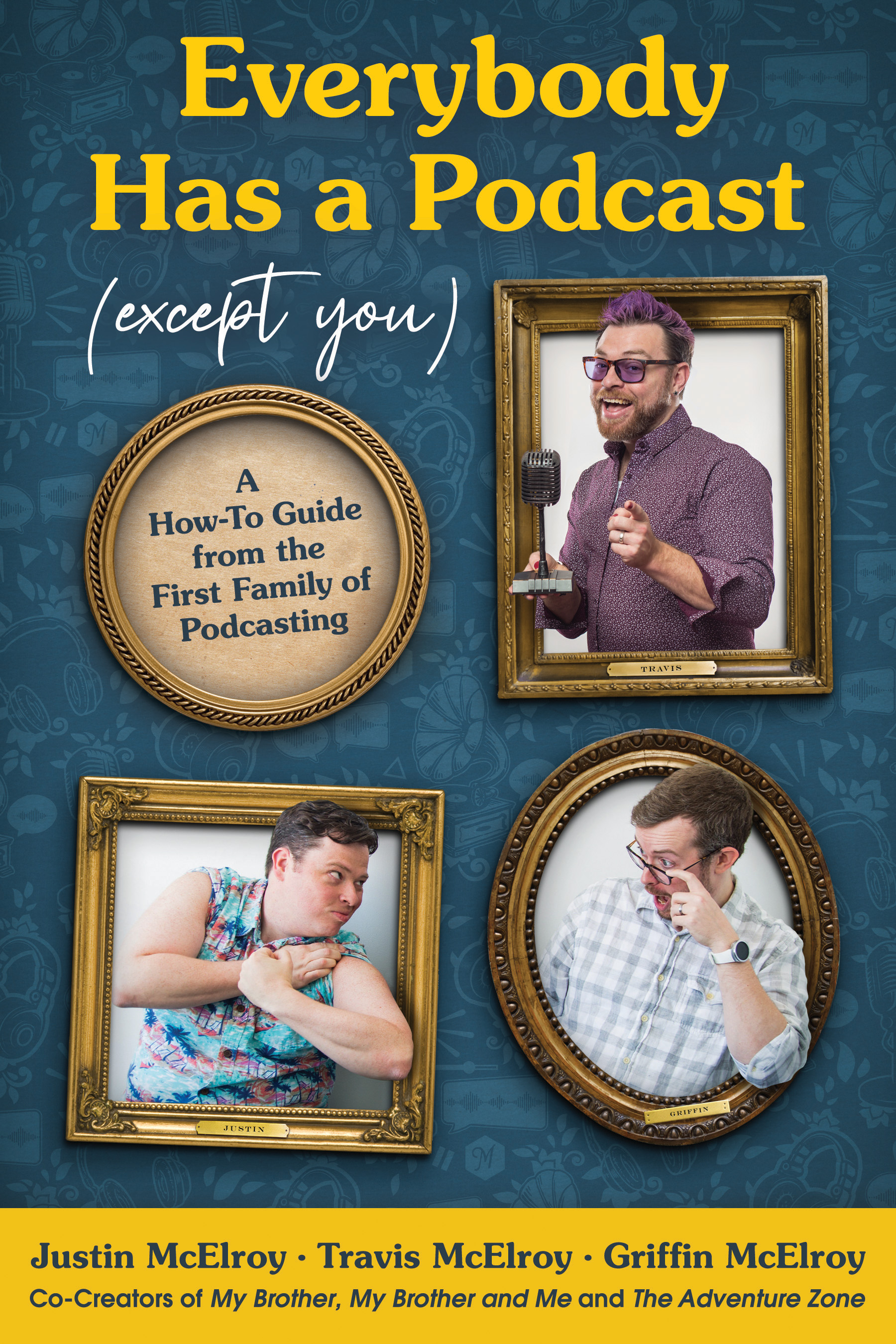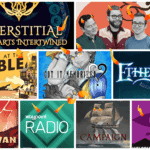My Podcast, My Guide Book, and Me: The McElroys Venture Into Podcasting How-To

The McElroys, hosts of My Brother, My Brother, and Me and self-proclaimed “first family of podcasting,” are here with the 270+ page $23 podcast guide book Everybody Has a Podcast (Except You), or “EHaP” in short. The format is simple: Justin, Travis, and Griffin McElroy alternate chapters covering everything from preproduction to social media etiquette for growing an audience.
Writing a podcast book like this is a sisyphean undertaking in an industry where something as big as Spotify entering the field changes things overnight. EHaP is effectively joining a subgenre of how-to books primarily full of e-books promising the secrets to podcasting success that’re rotting on digital shelves, their advice outdated weeks after publication. It’s clear the McElroys are aware of this and great effort is made to thread that needle, giving personalized advice while also trying to keep the book evergreen enough to survive long-term.

It’s goofy.
In their promotion campaign for the book, the McElroys have made great strides to sell Everybody Has a Podcast as being entertaining as well as informative, promising they’ve made it as funny as possible. Funny enough, they urge fans, it’s worth buying even if one isn’t interested in podcasting. Oodles of callbacks are made, both to classic MBMBaM bits (e.g. Travis obliquely references the “Mango Cult” bit as evidence of how funny he is) and running bits from the book itself. Justin cautions the reader to not prematurely shop for a yacht with the money they’ll make from their new podcast during his intro to the monetization section. This opens the door for all three to make an absolute meal out of yacht jokes for multiple segments.
Readers of The Sawbones Book will be familiar with the comedy layout of EHaP, as the Sawbones house style of co-authors popping in via an infobox with a cartoon of their face is continued here.
As far as the jokes themselves: It’s all solid McElroy goof fare. Good enough that I occasionally would stop reading to show my fiance a particularly funny bit. I’d argue the comedy writing serves to make dry content palatable moreseo than make the book a must-own McElroy product on its own merits, but your mileage may vary.
It recommends okay equipment.
Woe is the person tasked with making microphone recording patterns and discussing the pros and cons of XLR vs. USB entertaining. The section specifically about equipment and audio recording is solid, with easy-to-understand descriptions of how sound bounces around recording spaces, great advice (e.g. moving blankets deaden more sound than $100+ mic isolation shields), and personal anecdotes.
Except for Travis’ Blue Yeti recommendation in the section on USB microphones, citing, “It’s a really versatile mic and very easy to set up.”
Read more: The Essential Podcast Equipment (for any budget)
He’s not wrong in that it’s physically easy to plug in, and it does have several recording patterns that make it a great all-purpose microphone. The issue with The Mic That YouTube Built is more that people new to having sensitive microphones aren’t given proper descriptions of the use-cases it’s best and worst at. YouTube is filled with tutorials showing new streamers and podcasters how to fine-tune the Yeti so it can’t hear their neighbor’s refrigerator thinking.
With great power comes great responsibility to give specifics when recommending microphones. I didn’t go in expecting an up-to-date recommendation of something like RØDE’s Yeti-killer (the NT-USB Mini), but it would’ve been nice to have a smidge more detail about what the Yeti is good at, similarly to what the Shure SM58 gets in the XLR section.
It defers to experience.
In an unexpected twist, the term “first family of podcasting” carries a double meaning in that there’s three bonus McElroys brought on for a topic the three brothers are less-equipped to speak to. The section “Research” is written by as Teresa, Sydnee, and Rachel McElroy, who handle the bulk of the research in their podcasts Shmanners, Sawbones, and Wonderful.
Podcasters with shows “about” a given topic, from beginners to chart-toppers, have a bad habit of basing an entire episode on one article (usually not properly sourced), occasionally going as far as to just read the relevant Wikipedia article line-by-line. Any big podcasters normalizing the concept of pre-production in general for newer podcasters is a great first step. Big podcasters normalizing the idea of responsible research and avoiding plagiarism? A godsend.
Everybody has a Podcast is written from an old-school perspective: the platonic idea of “a podcast” is a chat show akin to terrestrial radio’s morning commute shows.
Examples of establishing research goals, strategies to find reputable sources, and personal anecdotes on how the McElroys have screwed up (including how they fixed their habits to ensure those problems don’t reoccur) bolster a section full of solid generic research advice. This is the closest EHaP comes to feeling textbook-like in a good way. Genuine, actionable advice.
It’s not for fledgling fiction podcasters.
Everybody has a Podcast is written from an old-school perspective: the platonic idea of “a podcast” is a chat show akin to terrestrial radio’s morning commute shows. Anything else in the industry is “a podcast” with extra steps or effort added. This creates a bit of a hurdle when it comes to fiction podcasting, which shares very little DNA with chat shows.
The Adventure Zone (also often called “TAZ”) is one of the most successful actual play podcasts for the better part of six years, yet this book by the producers of that show never uses the term actual play (or audio drama for that matter). As far as EHaP is concerned, TAZ is “a podcast” in which the hosts play a tabletop RPG, not an inherently unique product in a different genre requiring different creative and workflow requirements.
This distinction might sound like nitpicking the semantics of genre differences, but it’s worth noting there is no specific advice in regards to making a fiction podcast in this how-to book by the hosts of a wildly successful fiction podcast. The closest it comes is an offhand comment from Griffin mentioning how large the multitrack for a TAZ finale was. Something along the lines of K.C. Wayland’s Bombs Always Beep: Creating Modern Audio Theater would be more of use for those looking to get into the storytelling and sound design side of podcasting.
It doesn’t discuss their bigger mistakes.
Anyone as active and successful in the industry as the McElroys will experience their fair share of missteps. It also makes perfect sense why they would avoid printing intimate details of gaffes that are hyper-specific to already having a full time podcasting job. There’s not much actionable advice in a blow-by-blow account of whatever happened to sour the launch of The Sawbones Book. That said, there have been a few notable past instances that could’ve facilitated some good real-talk advice for new podcasters.
In an aside during the chapter detailing social media etiquette, Justin cautions discussing usage rights with the artist making your podcast artwork, and to get an agreement in writing. “We’ve never done formal signed contracts or anything, but if you wanna be extra careful, go nuts.”
On August 31st, 2020 The Adventure Zone had to post a formal apology after several artists revealed First Second, publisher of the bestselling TAZ graphic novel adaptations, had severely underpaid for commissioned fanart in all three extant TAZ novels. According to their public statement, the McElroys were wholly unaware of how First Second was handling things and by all accounts the brothers made good with direct cash payments and a promise of more oversight for future adaptations.
With that event under their belt, one would think there’d be a warning in their how-to guide urging podcasters to keep a watchful eye over their own IP and make sure all involved are fairly compensated. The closest Everybody Has a Podcast (Except You) comes is Travis saying to always pay for artwork and saying he has paid “anywhere from $100 to $500 for album art, depending on how complicated the project is.”
A dark shadow cast across certain sections if one knows about previous controversies. The aforementioned social media chapter also specifically urges new podcasters to not create Facebook groups for their own shows. This hits different if the reader knows about the implosion of the Still Buffering Facebook group. Addressing the power imbalance of operating in a fan space for a podcast as the creator of that podcast is extremely good information for new podcasters (though, the lack of addressing the concept of parasocial relationships is felt). Strategically not mentioning how they learned that lesson when the McElroys have gained a lot of cultural cache off publicly taking their lumps feels off.
It’s a solid starting point.
A good jack-of-all-trades guide for a hobby should give the reader the tools they need to be able to ask further questions as they continue learning. For all its small faults, EHaP’s codification of key terms and specific advice in areas that would otherwise be difficult to look up advice specifically-geared to podcasting (e.g. research or social media strategy). Though someone with no podcasting experience will benefit most, there’s plenty of useful nuggets to justify the $23 USD price of admission.
Everybody Has a Podcast (Except You) is on sale today, January 26th 2021, via Harper Collins. It is available at all major, and many indie, booksellers.













Comments
Comments are closed.